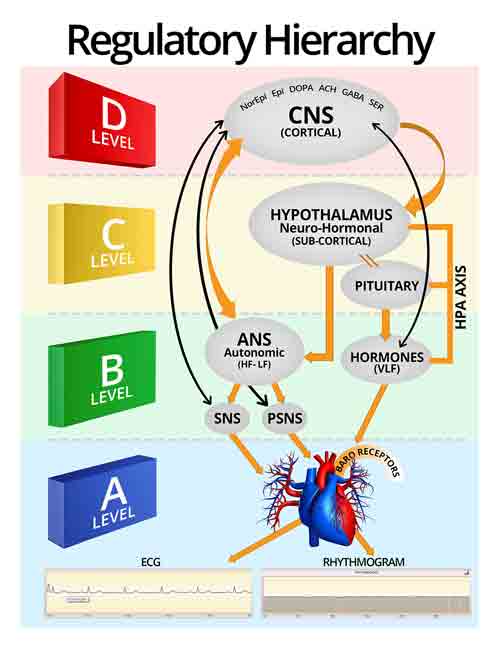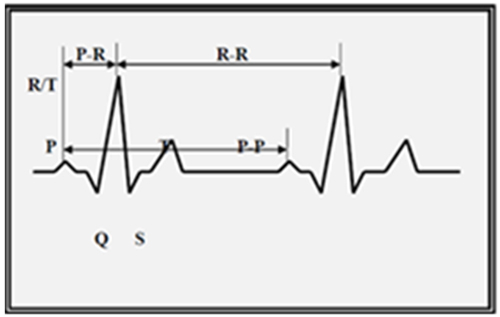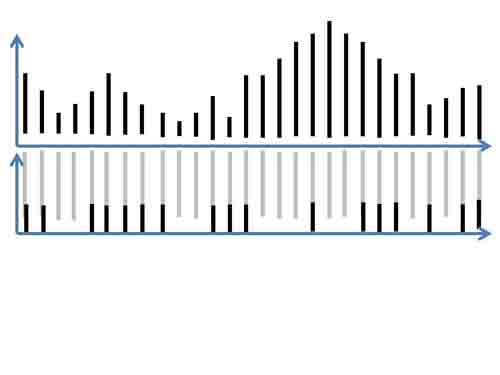Michael Kessler, DC, CCSP
Javdat Karimov, MD, NMD
When we look at how humans survived over time, it is clear that a very adaptive system was necessary, or we would not be here today. Advanced heart rate variability (HRV) can reflect our evolutionary biology and where we are today, in terms of our ability to adapt to multiple stressors. This specialized HRV gives us a quantitative view of our adaptive capabilities and predicts how all of our regulatory systems are working inside or outside a specific zone. When we look at homeostasis, we are looking at regulatory systems that are designed to adjust to internal and external input. For example, the pH of the blood must stay within a specific range of 7.35-7.45. If it moves in one direction, the body must bring it back the other way. If the metabolism becomes too anabolic, it adjusts to be more catabolic. The body has to be able to handle a specific amount of deviation; an inability to do so will show up in the advanced HRV numerical values.
The HRV system is not a diagnostic tool per se; however, it can tell us how well the regulatory systems are maintaining their adaptive capabilities within a certain variable fixed range. This insight from a patient’s HRV measurements can tell us whether that person’s lifestyle is conducive to being healthy or is pushing him or her outside of this highly variable but defined zone. It is then up to the physician to use tools based on his/her training to bring that patient into a better HRV balance, or closer to peak performance. This is an education technology that allows both patient and healthcare provider to see with a high degree of accuracy the adaptive response of the nervous system and other regulatory systems.
Regulators of the Human Organism
ANS, CarThe hypothalamus is the bridge between neurological and hormonal regulation. With the help of the hypothalamus, we receive all internal inputs, such as pain, emotions, body temperature, fluid, electrolyte balance appetite, sleep cycles, etc. This information goes through the hypothalamus and on to other parts of the brain. The brain interprets this information and then sends neural input back to the hypothalamus, which encodes this information and sends its own signals to the autonomic nervous system (ANS) and/or hormonal system. If the ANS cannot perform its regulatory work in the proper fashion, the hormonal system will take over. When we see this happening, the very-low-frequency (VLF), or neurohormonal, portion of the spectral analysis will increase. What this means is that the central nervous system (CNS) regulation is becoming predominant. In other words, we are shifting from ANS regulation, which is a more efficient and less energy-consuming system, to a cortico-hypothalamic-hormonal regulatory system. This is a much slower-reacting and more energy-consuming regulatory system in the body compared to the ANS. The net result of this process is greater hormonal input. In this situation, the hypothalamic-pituitary axis is over-stimulated and, over time, becomes exhausted.
When we look at A for Cardiovascular Adaptation, B for Autonomic Regulation, C for Neurohormonal Regulation and D for Psycho-Emotional State (Figure 1), it is imperative to understand how these regulatory values were established. With Neurodynamic Coding, scientists are able to interpret a signal from the CNS and translate this signal into 2 languages: ANS and hormonal input.1, 2 From the heart recording of the EKG, we can trace information, just like UPS can track packages from where they originated, all the way to their final destination. This comes from measuring 5 different intervals in the EKG, and then specifically evaluating how well these measured intervals are following the fractals and golden ratio, or natural laws of nature. As described in detail below, these mathematical measurements from the Q-R-S-T complex of an EKG are used to extract a neurohormonal (or neurodynamic) code from the rhythmogram. (Please refer to our previous 2 articles for more background.)

Calculating a Neurodynamic Code from the Rhythmogram
A Neurodynamic Code is arrived at in the following way:
- An EKG is performed in order to evaluate the Q-R-S-T complex (Figure 2).
- The EKG is converted into a rhythmogram by turning the horizontal R-R waves vertically. The rhythmogram makes it possible to decrypt information from the EKG about the body’s regulatory system; this rhythm is reflected in the dynamics of the heart. The rhythmogram is then translated into a neurodynamic code (Figure 3) Just as the “black box” in an airplane accurately records all conversations between pilots, the human heart objectively and accurately reflects regulatory changes occurring in the body. Neurodynamic coding essentially allows us to read the black box.


- Figure 4. Outcome of Neurodynamic Coding Multiple scores are compiled as a result of this mathematical process, which reflect a person’s overall health, ANS and neurohormonal regulation, cardiovascular adaptation, and psycho-emotional state (Figure 4).
HRV and The Golden Ratio
Using the neurodynamic coding from the EKG rhythmogram, we get the information about ABCD in Figure 1, which provides a comprehensive view of a patient. To decipher the code from the cardiorhythm (a combination of the EKG and the rhythmogram), we utilize mathematics that are applicable to all complex living things and all material structures within the universe. This is the “golden ratio” in mathematics and is seen in fractals or repeating patterns in nature. All physiological processes in the body have similar patterns, just in different time scales. For example, the body’s response to external stressors is reflected in brain electrical activity in a fraction of a second, whereas changes in the activity of the heart occur in seconds; blood pressure changes over tens of seconds, and even more time is needed for adaptation of other bodily systems. Because of the similarity between patterns, however, examining the dynamics of the heart simultaneously reveals the structure and dynamics of other systems.
In their research, Russian scientists noticed deviations from these normal patterns. For those of you who are interested in fractals you can find a great movie on the subject, produced by Nova. It’s called “Hunting the Hidden Dimension.” Another video we recommend is called “Fractal Wisdom,” by Bruce Lipton, available on YouTube.
Within the fractal, or golden ratio, the encoding process used by Russian scientists enabled them to calculate and predict when a certain part of the regulatory system was out of synch with the normal pattern of nature. When we refer to anabolic metabolism, we are talking about the building of tissues such as fat, bone, muscle, and connective tissue. Catabolic metabolism, in contrast, involves the breaking-down of these same tissues. The balance between anabolic and catabolic is found within this well-defined golden ratio. Classical physiology explains that catabolic and anabolic metabolism must be equally balanced. In reality, we could not function in a healthy way if we did not alternately increase one of the reactions. For example, we would not grow if we did not increase the anabolic reaction over the catabolic reaction. If you make $5000 a month and you spend $5000 a month, you will be broke. However, if you make $50 000 a month and spend only $5000 a month, you will make progress. From the age of 0 to 25 years, we have high anabolic metabolism. Even though traditional physiology dictates that these reactions should be equal, this does not in reality make sense.
Scientists use the term “predictive changes” when looking at a person’s fractal neurodynamics to see whether he has deviated from the normal fractal pattern.1,2,3 This can tell us how much we can increase the anabolic or catabolic reaction to be healthy. Too much anabolic metabolism can mean tumor growth. Thus, we are looking at predictive changes and stability within a system.
The other part of this picture is “demand.” A good example is an athlete who has to run 1 mile. During this time he will increase his catabolic physiology to produce enough ATP (energy) to run as fast as possible. After running, he will need to return to anabolic physiology, or HF (high-frequency), to compensate for the energy expense. Within these physiological compensations, there is a boundary that was designed by nature. In mathematics, these numbers are called Fibonacci, related to fractal neurodynamics and the golden ratio. If we follow the natural law, everything is under control. This process is a non-linear mathematical calculation. This is how scientists are able to see how flexible a system is functioning within a certain parameter.
Vital Force and Autocorrelation
If we analyze Vital Force, it will measure high when a person’s metabolic state is able to switch easily and frequently between anabolic and catabolic, based on the body’s needs. This is based on a calculation called Autocorrelation, shown in Figure 5. Autocorrelation is not visually shown on HRV, but is hidden under the hood of the device. The Vital Force is calculated by analyzing certain relationships between P-R, R-R, R-T, P-T intervals on the EKG.1, 2 When one aspect of the PR complex wave increases, for example, another may go down.

Vital Force is also relevant when discussing stress. One person can handle a certain amount of stress, while another person under the same amount of stress has a myocardial infarction (MI). If you check HRV in an individual and you see a low-frequency (LF) band at 90% (indicating a predominance of sympathetic nervous system activity) but the Vital Force is at 450 (range: 50-500), you can assume that this person can handle stress, and that his autonomic regulation is under control because it can compensate. Take another person with a 90% LF but a Vital Force of only 10, and she’ll mostly likely have all sorts of stress reactions including a possible MI. This is another reason why most HRV systems come up short. They typically only look at LF, HF and SDNN (standard deviation of normal reference range intervals between sinus beats), but do not include the Autocorrelation mathematical index with which to calculate Vital Force.When the Vital Force is low, the metabolic state cannot adjust to increased metabolic demand, simply because there is not enough energy to keep the metabolism dynamic within the golden ratio, or to help it compensate to the right or left. Catabolic cannot shift to anabolic, and vice versa. Because Vital Force maintains the balance of metabolic reactions, a low Vital Force can result in either catabolic reactions dominating metabolism (and premature aging), or the progression of anabolic reactions (and eventual tumor growth).
It is important to look at a Spectrum Diagram, consisting not only of LF, HF, VLF, and their percentages, but also Vital Force (Figure 6). A helpful analogy is a vehicle in which LF is the engine and Vital Force is the gas. If the gas tank is empty you will not get very far because you are already exhausted. In traditional HRV, doctors will say a person is healthy when they see a high percentage of HF, or high frequency (high parasympathetic nervous system activity). This would be a positive HRV reading only if the Vital Force was high. A low Vital Force could mean adrenal exhaustion. This is why including the Vital Force measurement in advanced HRV provides a more accurate reflection of a subject’s health.

Closing Comments
(LF=low-frequency; HF=high-frequency; VLF=very low-frequency; Symp.NS=sympathetic nervous system; ParaSymp.NS=parasympathetic nervous system; SDNN=standard deviation of normal reference range intervals between consecutive sinus beats; CNS=central nervous system; ANS=autonomic nervous system)
Using the advanced HRV makes it is easy to interpret how well a subject is able to adapt to stress and manage his or her metabolic energy. What makes advanced HRV unique is the ability to see when the ABCD parameters and Vital Force are working within the natural laws of nature. It is when measurements are outside of this zone that systems break down and we lose our compensatory resilience.
In the next issue we will discuss the 6 elements, hormones and mineral balances derived from HRV. The science in this field is constantly evolving, and we look forward to keeping you informed.
 Michael Kessler, DC,CCSP, has 25 years clinical practice, with a primary focus on nutritional and energetic therapies. He is highly experienced in the integration of advanced healing methods, systems and devices. Dr Kessler is the author of 4 books published through Lombardi Press: The 8-Day Detox Breakthrough; The New Medicine Cure; Doctor’s Home Remedies That Work; and New Breakthroughs in Natural Pain Healing. He has also written articles on a monthly basis for several years for a health newsletter for Lombardi. Dr Kessler has taught numerous workshops on a variety of topics for Designs for Health, Biotics Research, and Nutrienergetics Systems, and has lectured for the Academy of Complementary and Integrative Medicine. He currently teaches individual practitioners how to integrate a variety of modalities into their practices to help localize the core imbalances that are contributing to their patients’ health problems.
Michael Kessler, DC,CCSP, has 25 years clinical practice, with a primary focus on nutritional and energetic therapies. He is highly experienced in the integration of advanced healing methods, systems and devices. Dr Kessler is the author of 4 books published through Lombardi Press: The 8-Day Detox Breakthrough; The New Medicine Cure; Doctor’s Home Remedies That Work; and New Breakthroughs in Natural Pain Healing. He has also written articles on a monthly basis for several years for a health newsletter for Lombardi. Dr Kessler has taught numerous workshops on a variety of topics for Designs for Health, Biotics Research, and Nutrienergetics Systems, and has lectured for the Academy of Complementary and Integrative Medicine. He currently teaches individual practitioners how to integrate a variety of modalities into their practices to help localize the core imbalances that are contributing to their patients’ health problems.
 Javdat Karimov, MD, NMD, is a naturopathic physician with an MD background (Russia) in anesthesiology and emergency medicine. He graduated from National College of Naturopathic Medicine in 2003, and since then has maintained a private practice in Portland, Oregon. Dr Karimov has over 20 years of clinical experience focusing on cardiology, Eastern medicine (Traditional Chinese Medicine), Ayurveda, Tibetan and Quantum healing. Dr Karimov is actively involved in researching the health benefits of quantum medicine. In addition to his clinical work, Dr Karimov is CEO of Global Health Solutions, where he designs and sells assessment tools for the healthcare practitioner.
Javdat Karimov, MD, NMD, is a naturopathic physician with an MD background (Russia) in anesthesiology and emergency medicine. He graduated from National College of Naturopathic Medicine in 2003, and since then has maintained a private practice in Portland, Oregon. Dr Karimov has over 20 years of clinical experience focusing on cardiology, Eastern medicine (Traditional Chinese Medicine), Ayurveda, Tibetan and Quantum healing. Dr Karimov is actively involved in researching the health benefits of quantum medicine. In addition to his clinical work, Dr Karimov is CEO of Global Health Solutions, where he designs and sells assessment tools for the healthcare practitioner.


